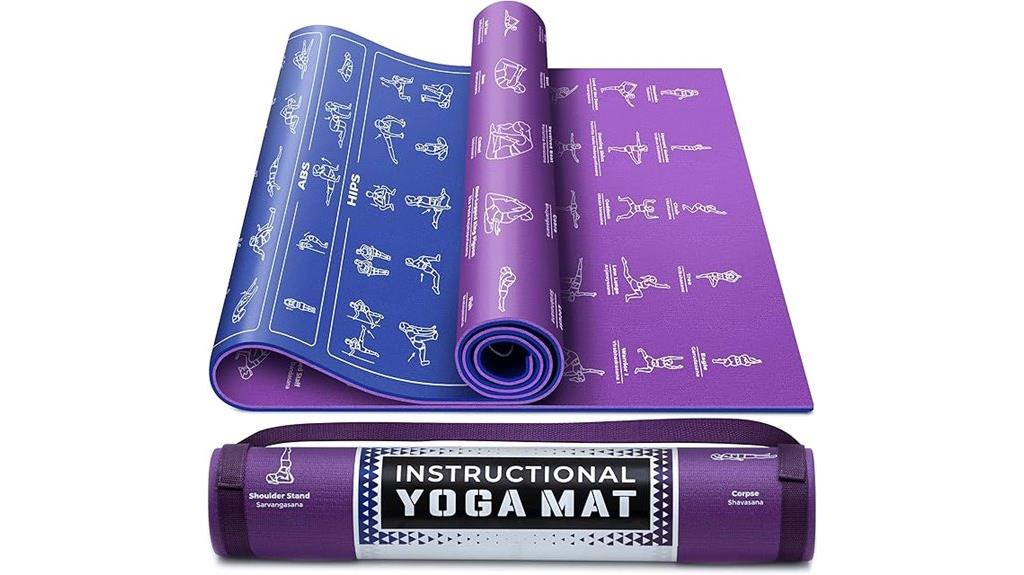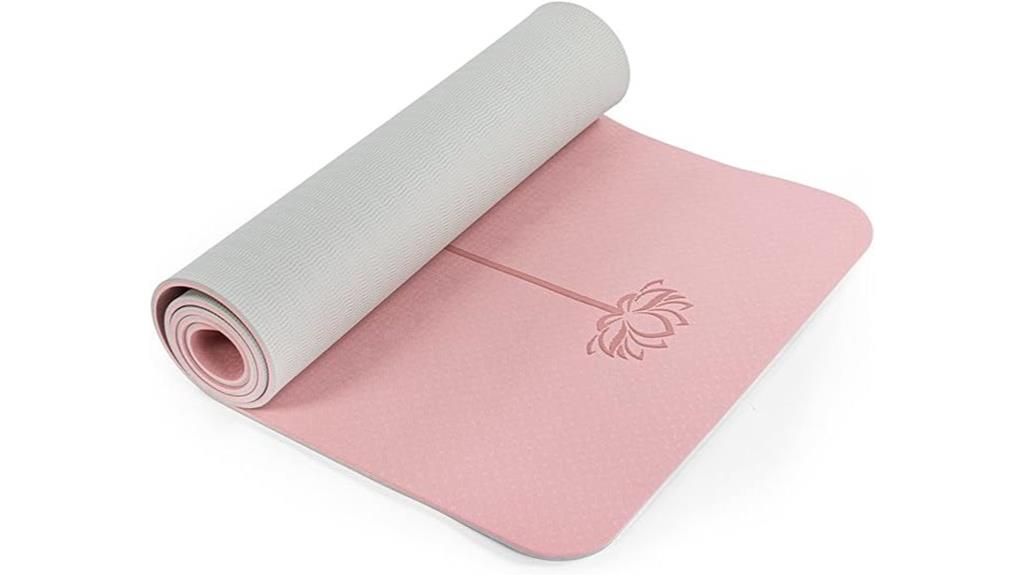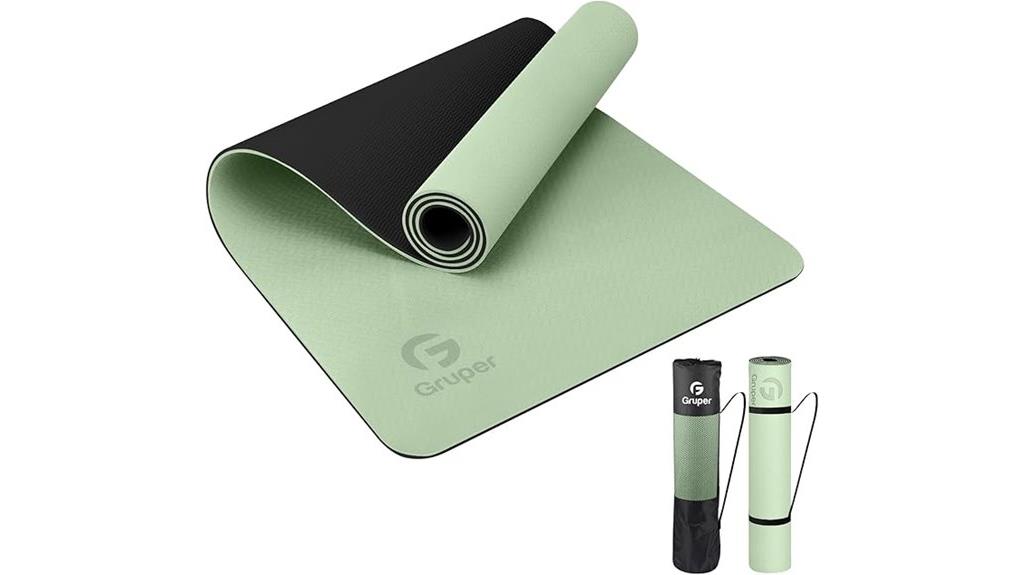If you’re looking for the best non-slip yoga mats for beginners, I recommend options that prioritize grip, comfort, and eco-friendliness. I personally like mats with textured surfaces, good cushioning, and lightweight designs, like the Instructional Yoga Mat or Retrospec Solana. Durability and easy maintenance also matter, so eco-friendly materials like TPE are great. Keep exploring to find the perfect fit that balances safety, comfort, and sustainability for your practice.
Key Takeaways
- Prioritize mats with textured, non-slip surfaces to ensure secure footing during various poses.
- Choose appropriate thickness (1/4 inch or more) for cushioning without sacrificing stability.
- Select mats made from eco-friendly, non-toxic materials like TPE or natural rubber for safety and sustainability.
- Ensure the mat size provides enough space (at least 68 inches long) for comfortable movement and practice.
- Opt for durable, easy-to-clean mats with reinforced construction to withstand regular use and maintain safety.
Instructional Yoga Mat with Carrying Strap

If you’re just starting out with yoga, the Instructional Yoga Mat with Carrying Strap is an excellent choice because it combines visual guidance with portability. The mat features 75 illustrated poses and stretching exercises, making it easy to follow routines on your own. Its size of 68”x24” and 6mm thickness provide extra cushioning, reducing pressure on your joints. Made from non-toxic, eco-friendly PVC, it’s safe, durable, and slip-resistant. Plus, the included carrying strap makes it simple to take your practice anywhere—whether at home, outdoors, or in class. This mat helps you build confidence while enjoying a comfortable, safe workout.
Best For: Beginners and experienced yoga practitioners seeking an easy-to-follow, portable, and comfortable mat for home or outdoor practice.
Pros:
- Features 75 illustrated yoga poses and stretching exercises for comprehensive guidance
- Thick 6mm cushioning provides enhanced comfort and joint protection
- Comes with a carrying strap, making it easy to transport and practice anywhere
Cons:
- Larger size may be less convenient to store in tight spaces
- PVC material, while eco-friendly and non-toxic, is less biodegradable than some alternatives
- The printed illustrations may wear over time with intense use
Retrospec Solana Yoga Mat with Nylon Strap

The Retrospec Solana Yoga Mat with Nylon Strap is an excellent choice for beginners seeking comfort and convenience. Its 1-inch thick padding provides extra support, reducing pressure on joints and enhancing stability during practice. The generous 72 x 24-inch size offers plenty of space for various exercises, making it versatile for yoga, Pilates, or stretching. Its non-slip surface ensures a secure footing, minimizing injury risk and boosting confidence. Made from durable, eco-friendly materials, this mat is built for daily use. The included nylon strap makes it easy to carry, so you can practice at home or on the go without hassle.
Best For: Beginners and casual practitioners seeking a comfortable, stable, and portable yoga mat for home, studio, or on-the-go use.
Pros:
- Extra thick 1-inch padding for enhanced comfort and joint support
- Non-slip surface for secure footing and safety during practice
- Durable, eco-friendly materials suitable for daily use and easy to clean
Cons:
- Initial odor may be present; requires airing out before use
- Larger size may be less convenient for small storage spaces or travel
- May be too thick for advanced practitioners seeking a more minimal feel
Amazon Basics Extra Thick Exercise Yoga Mat with Carrying Strap

For beginners seeking extra cushioning and reliable support during their workouts, the Amazon Basics Extra Thick Exercise Yoga Mat is an excellent choice. Made of durable 100% NBR foam, it offers 1/2 inch of padding, providing shock absorption and comfort during extended sessions. The textured surface enhances traction, reducing the risk of slipping. Its generous size (about 73.2 x 24.3 inches) and lightweight design make it easy to carry, especially with the included elastic strap. Perfect for yoga, gym workouts, or outdoor exercise, this mat combines durability, support, and portability for a safe, comfortable practice.
Best For: beginners and exercisers seeking extra cushioning, support, and portability for yoga, gym workouts, or outdoor activities.
Pros:
- Extra thick 1/2 inch padding provides excellent shock absorption and comfort during extended use
- Textured surface enhances traction, reducing slipping risks during various exercises
- Lightweight with included elastic strap makes it easy to carry and store on the go
Cons:
- Made of NBR foam, which may wear faster with intense or prolonged use over time
- Hand wash only, requiring more care for cleaning and maintenance
- Slightly bulkier compared to thinner mats, which may be less convenient for highly portable needs
Yoga Mat Non Slip, Pilates Fitness Mats, Eco Friendly, Anti-Tear 1/4″ Thick Yoga Mats for Women

When starting out with yoga or Pilates, having a reliable mat that stays firmly in place is essential, especially during sweaty sessions. I recommend the UMINEUX eco-friendly mat for its double-sided non-slip surfaces and textured design, which provide excellent traction even when you’re sweating. It’s made from soft, skin-friendly TPE, free from PVC, and lightweight, making it easy to carry around. The 1/4-inch thickness offers comfort and durability without sacrificing stability. Plus, it’s anti-tear and recyclable, so you can practice confidently while caring for the environment. The included carry strap and storage bag make it perfect for on-the-go workouts.
Best For: individuals seeking an eco-friendly, non-slip yoga or Pilates mat that offers comfort, durability, and portability for all fitness levels.
Pros:
- Double-sided non-slip textured surfaces ensure excellent grip during sweaty workouts
- Made from soft, skin-friendly, and recyclable TPE material free from PVC and irritating smells
- Lightweight and comes with a carry strap and storage bag for easy transport and storage
Cons:
- Designed primarily for barefoot exercises; shoes or pet paws may damage the mat
- Not suitable for machine washing; requires careful cleaning with damp cloth or mild detergent
- May wear out faster if used with shoes or rough surfaces due to its anti-tear design
Yoga Mat Non Slip, Eco Friendly Fitness Exercise Mat with Carrying Strap

If you’re just starting out with yoga or fitness exercises, this non-slip, eco-friendly yoga mat is an ideal choice because it provides reliable grip and safety during your practice. Made from premium, eco-friendly materials, it’s softer and safer than traditional PVC or EVA mats. The textured surface on both sides ensures excellent grip, even during intense moves. Its double-layer design offers enhanced durability, resisting tearing and deformation. Plus, it’s lightweight and comes with a carrying strap and storage bag, making it easy to take to the gym or studio. Whether you’re doing yoga, Pilates, or other workouts, this mat keeps you stable and comfortable.
Best For: Beginners and fitness enthusiasts seeking a safe, eco-friendly, and non-slip yoga mat for various exercises, including yoga and Pilates.
Pros:
- Made from premium eco-friendly materials, safer and softer than traditional PVC and EVA mats.
- Double-layer design enhances durability, resisting tearing and deformation.
- Comes with a carrying strap and storage bag for easy portability.
Cons:
- Not suitable for use with shoes or pet paws, which may damage the surface.
- Requires cleaning with a damp cloth or mild detergent; not machine washable.
- Slightly heavier than some minimalist mats, which may affect portability for some users.
Factors to Consider When Choosing a Yoga Mat for Beginners Non Slip

When choosing a non-slip yoga mat, I consider the surface material to guarantee it offers solid grip during practice. I also look at thickness for comfort and stability, along with size and portability for convenience. Finally, eco-friendliness and durability matter to me, so I pick a mat that’s both sustainable and long-lasting.
Slip-Resistant Surface Material
Choosing the right slip-resistant surface material is essential for ensuring safety and stability during your yoga practice. Materials like TPE, natural rubber, or textured PVC are popular because they provide excellent grip, even when you’re sweaty or holding challenging poses. Double-sided textured surfaces offer extra traction, helping you stay grounded on both sides of the mat. The textured pattern on the surface increases friction, markedly reducing the risk of slipping. This improved grip not only enhances safety but also helps you maintain proper alignment throughout your routine. When selecting a mat, prioritize those with a non-slip surface that offers reliable traction, so you can focus on your practice without worrying about slipping or losing balance. The right surface material makes all the difference in practicing safely and confidently.
Thickness and Cushioning Level
Selecting the right thickness and cushioning level for your yoga mat is essential for guaranteeing comfort and stability during practice. Thicker mats, from 1/4 inch to 1 inch, offer extra cushioning that reduces pressure on joints and knees, making poses more comfortable. However, increased thickness can sometimes decrease stability, so finding a balance is key to maintaining proper alignment. For beginners, especially those building strength and balance, a thicker mat can help prevent discomfort and injury. The cushioning level should match your yoga style—more padding for restorative or gentle practices. Also, consider your personal preferences and any joint issues you might have. Choosing the right thickness ensures you stay comfortable, secure, and focused throughout your practice.
Size and Portability Features
Finding the right size and portability features for your yoga mat is essential for a comfortable and convenient practice. I recommend choosing a mat that’s at least 68 inches long—this gives enough space for most poses without feeling cramped. A width of 24 inches provides ample room for various movements, helping you stay balanced and safe. If you plan to carry your mat around, look for lightweight options or mats with carrying straps, making transportation easier. Balance is key: select dimensions that are easy to carry but still offer enough surface area for effective practice. A thickness of around 1/4 inch offers comfort and support without adding unnecessary weight. Prioritizing size and portability ensures your yoga sessions are accessible and enjoyable, wherever you practice.
Eco-Friendly Material Benefits
When considering size and portability features, it’s also important to think about the materials your yoga mat is made from. Eco-friendly mats are often crafted from sustainable materials like TPE, natural rubber, or recycled foam, which help reduce environmental impact. These mats are free from harmful chemicals such as PVC, phthalates, or heavy metals, making them safer for your skin and respiratory health. Additionally, eco-friendly mats are usually biodegradable or recyclable, helping to cut down on long-term waste in landfills. They also tend to have non-slip surfaces that provide reliable grip, even when you sweat or practice vigorously. Choosing eco-friendly materials not only benefits the environment but also supports your overall health and well-being during your yoga practice.
Durability and Tearing Resistance
Durability and tearing resistance are crucial factors to contemplate because a yoga mat that withstands regular use saves you money and frustration over time. High-quality materials like TPE, PVC, or thick foam ensure your mat resists tearing and maintains its shape. Double-layer constructions further enhance durability by preventing cracking or splitting during vigorous sessions. Thicker mats, around 1/4 inch or even 1 inch, are more resistant to tears and offer better longevity, especially during intense poses. A textured surface not only provides grip but also reduces stress on the material, minimizing the risk of tears caused by slipping or excessive wear. Proper storage and regular cleaning also help preserve the mat’s integrity, ensuring it stays tear-free and reliable through consistent practice.
Ease of Cleaning Process
A yoga mat that’s easy to clean can make a big difference in maintaining hygiene and extending its lifespan. I look for mats with surfaces that can be wiped down quickly with a damp cloth or mild detergent, making cleanup simple after every session. Materials like TPE or PVC are ideal because they resist staining and are straightforward to clean without special products. I avoid mats with complex textures or deep grooves since dirt and sweat can get trapped, requiring more intensive scrubbing. Regular cleaning prevents bacteria buildup and keeps the mat in good condition longer. It’s also important to check manufacturer instructions to ensure cleaning methods won’t damage the material. Overall, an easy-to-clean mat helps me stay hygienic and saves time.
Price and Value Balance
Finding the right balance between price and value is essential when choosing a non-slip yoga mat as a beginner. While cheaper mats may save you money upfront, they often lack the durability, grip, and padding needed for safe practice, meaning you’ll likely replace them sooner. On the other hand, higher-priced mats tend to offer better longevity, comfort, and safety features, providing better long-term value. A mid-range mat with double-sided non-slip surfaces and eco-friendly materials strikes a good balance, offering quality without overspending. Considering the longevity and performance of the mat helps prevent injuries and enhances your practice. Comparing price-to-feature ratios ensures you select a mat that meets your needs without unnecessary costs, making your investment both practical and beneficial.
Frequently Asked Questions
How Do I Clean and Maintain My Non-Slip Yoga Mat?
To keep my non-slip yoga mat clean and in top shape, I wipe it down after every use with a mixture of water and mild soap or a gentle yoga mat cleaner. I avoid harsh chemicals that can damage the surface. I also roll it up loosely and store it in a cool, dry place. Regular cleaning helps maintain its grip and prolongs its lifespan, ensuring safe practice every time.
What Is the Ideal Thickness for Beginner Non-Slip Yoga Mats?
I recommend a thickness of about 4 to 6mm for beginner non-slip yoga mats. It offers enough cushioning to protect your joints and provides stability for balancing poses. Thinner mats, around 1-3mm, might feel less comfortable, while thicker ones over 6mm could reduce stability. For beginners, I find this range strikes a perfect balance between comfort and control, helping you practice safely and confidently.
Are Eco-Friendly Mats as Durable as Traditional Materials?
Yes, eco-friendly mats can be just as durable as traditional ones. I’ve found that many sustainably-made mats use high-quality recycled or natural materials that stand up well to regular practice. While some might worry about longevity, I believe choosing reputable brands guarantees durability. Plus, eco mats often offer excellent grip and comfort, making them a smart choice for both the environment and your practice.
Can I Use a Non-Slip Yoga Mat Outdoors Safely?
Absolutely, you can use a non-slip yoga mat outdoors safely. I do it all the time—on grass, concrete, or even sand. Just make sure the surface isn’t too uneven or wet, as it can affect grip and stability. I also wipe my mat clean after outdoor sessions to keep it in top condition. With the right care, your non-slip mat can be your trusty outdoor yoga companion.
How Often Should I Replace My Yoga Mat for Optimal Safety?
I recommend replacing your yoga mat every 6 to 12 months for maximum safety, especially if you practice regularly. Over time, mats can accumulate dirt, sweat, and wear, reducing their grip and cushioning. If you notice tears, persistent odors, or a loss of traction, it’s time to get a new one. Regularly inspecting your mat helps guarantee you stay safe and comfortable during every practice.
Conclusion
Choosing the right non-slip yoga mat can make all the difference, especially if you’re just starting out. I once watched a friend struggle on a slippery mat, nearly losing her balance during a pose. After switching to a more secure, eco-friendly option, she felt confident and steady. Remember, a good grip isn’t just comfort — it’s safety. So take your time, pick wisely, and enjoy your yoga journey with stability and peace of mind.










